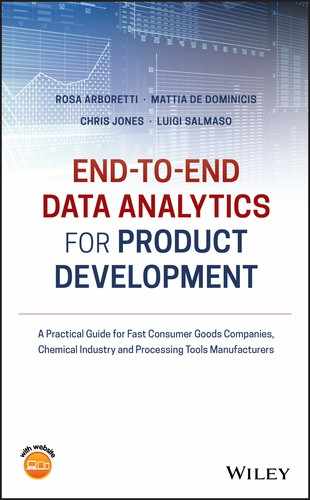Index
- “Appropriateness” 94–97
- c
- Central composite designs (CCDs) 137, 142–144
- face‐centered 145–147
- Central tendency 41
- Chi‐square test 269–270
- Coded coefficients 160–161
- Coded units 51
- Coefficient of determination 239
- Coefficient of variation 11
- Condom project
- Confidence interval (CI) 15–17, 231–232
- Confidence level 17
- Consumer voice 257
- Contingency table. See Cross tabulations
- Contour plots 165–166, 209–210, 212, 232, 234
- Correlation analysis 218–219
- Correlation coefficients 215–224
- Cross tabulations 264–265
- “Difference:A_B” 98–100
- m
- Mean 7
- Median 7
- Mixture designs
- components 167
- designed factor level combinations 199
- experimental design 167–199
- linear constraints 195–198
- lower and upper limits for components 187–195
- lower limits for components 175–178
- mixture‐amount experiment 181–183
- mixture‐process variable experiment 178–181
- response optimization 207–209
- response surface and locate the optimum 209–212
- response variables 200–202
- second‐order model 202–207
- simple mixture experiment 167–175, 183–187
- statistical analyses 199–200
- variables setting 200
- Mixture experiment 167, 170–173
- Mixture models 199
- Mix‐Up Project
- components 167
- designed factor level combinations 199
- experimental design 167–199
- linear constraints 195–198
- lower and upper limits for components 187–195
- lower limits for components 175–178
- mixture‐amount experiment 181–183
- mixture‐process variable experiment 178–181
- response optimization 207–209
- response surface and locate the optimum 209–212
- response variables 200–202
- second‐order model 202–207
- simple mixture experiment 167–175, 183–187
- statistical analyses 199–200
- variables setting 200
- Multi‐factor ANOVA 45
- Multiple linear regression model 224–226, 243
- p
- Paired t‐test 100–103
- Pareto chart 43
- Pearson correlation. See Correlation coefficients
- Pie Charts 266–267
- Point estimate 15–16
- Polymer Project
- Box‐Behnken Design 147–150
- central composite designs 139–144
- experimental design 139–150
- face‐centered CCD 145–147
- product's elasticity 138
- reduce the model 157–161
- response optimization 162–164
- response surface and locate the optimum 165–166
- response variables 150, 151–153
- second‐order model 138, 153–157
- statistical analysis 150
- variables setting 151
- Population parameters estimation 15–17
- Prediction interval (PI) 232
- Product validation 213
- p‐value 19–20, 44, 159
- r
- Random 3
- Random batch factor
- Randomization 28, 54
- Randomized complete block design (RCBD) 28–29
- Random samples 54
- Range 9
- Regression analysis 218–219
- Regression equation 229–230
- Regression model 51, 234–235
- Regurgitation
- Replication 29–30
- Residuals 239
- Response surface designs
- Box‐Behnken Design 147–150
- central composite designs 139–144
- experimental design 139–150
- face‐centered CCD 145–147
- product's elasticity 138
- reduce the model 157–161
- response optimization 162–164
- response surface and locate the optimum 165–166
- response variables 150, 151–153
- second‐order model 138, 153–157
- statistical analysis 150
- variables setting 151
- Response surface model 110, 114–118
- Response variables 24–25, 111–114, 234
- R‐squared 49–50
- R‐squared (R‐sq, R2) 49–50, 121, 160, 205, 228
- s
- Sample 3
- Scatterplot 215–224
- Scatterplot of thickness
- vs. CEW 236–238
- Screening experiment 24–37
- Shapes of data distributions 5–6
- for quantitative variables 6–7
- Simple linear regression models 236–239
- Simplex centroid design 174
- Simplex lattice design 167
- simple mixture experiment 183–187
- Spearman rank correlation 274–276
- Stain Removal Project 58
- Standard deviation 10–11
- Statistical analyses 37–55
- Statistical unit 3
- Statistical variables 2–3
- Surface plots 165–166, 209–210, 232, 234
- u
- Uncoded units 51
..................Content has been hidden....................
You can't read the all page of ebook, please click here login for view all page.
